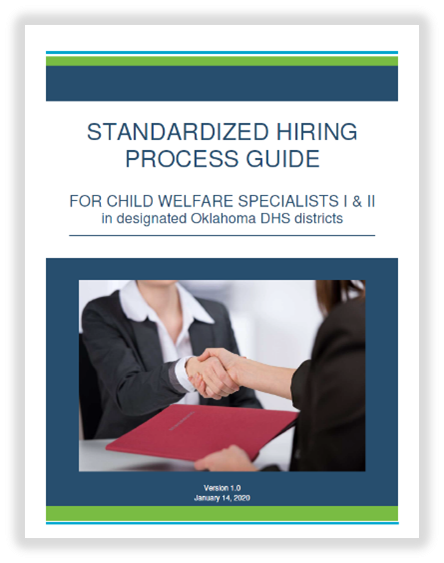Oklahoma Progress Update - A Revised Employee Selection Process: Virtual & Paperless
“I am convinced that nothing we do is more important than hiring and developing people. At the end of the day, you bet on people, not on strategies.” – Lawrence Bossidy, former CEO of Honeywell International Inc.
This quote is especially true for child welfare workers. Child welfare work is difficult and demanding; it requires compassion and attention to detail. Oklahoma Human Services (OKDHS), in partnership with the Quality Improvement Center for Workforce Development (QIC-WD), worked throughout 2018 and 2019 to create a competency-based employee selection process for Child Welfare Services (CWS) workers. Competencies are the knowledge, skills, abilities, behaviors, and other characteristics that one needs to successfully perform a job. Some competencies are learned on the job or in training, whereas others cannot be taught. Therefore, a competency-based selection process means that an employer is seeking candidates with the attributes that matter to job success but cannot, or will not, be learned on the job.
OKDHS and the QIC-WD first worked to define the competencies necessary for successful CWS workers. This complex process involved a series of interviews and focus groups with child welfare specialists and supervisors, representing the various child welfare tracks/specializations (Child Protective Services [CPS], Foster Care and Adoptions [FCA], Family Centered Services [FCS], Permanency Planning [PP], and Comprehensive). They participated in behavioral event interviews, designed to identify what people actually do on the job, as opposed to what they say they do. Figure 1 depicts the many steps and people involved in the process, which resulted in pages of transcripts that were coded for instances of behaviors related to important competencies. Ultimately the team identified 67 competencies critical to the CWS role.
Figure 1. Competency Modeling: Behavioral Event Interviews
The 67 preliminary competencies were further refined. A survey was sent out to 1,500 OKDHS child welfare specialists, supervisors, managers, and district directors to get feedback on the importance of each competency for the CWS job. The goal of the survey was to identify the most important competencies that are needed at the time of hire. Ultimately, 24 competencies were identified and used to inform the development of a standardized hiring process.
The measures that comprise the standardized hiring process were developed with input from a workgroup of supervisors and includes a writing assessment, typing assessment, and structured interview questions. The interview includes behavioral (what did you do?) and situational (what would you do?) questions. Rating scales are used to assess responses to both the writing assessment and oral interview. Figure 2 provides an example of a concrete scoring categories that measure compassion. The rating of “NR” stands for No Rating and has a score of zero points; “RF” is “Red Flag,” indicating that a respondent has said something that gravely concerns the person conducting the interview, and a score of negative five is associated with this response.
Figure 2. Example of Rating Scale to Examine Compassion
| Compassion: Genuinely cares about people, is concerned about their work and non-work problems, is available and ready to help, is sympathetic to the plight of others not as fortunate, and demonstrates real empathy with the joys and pains of others. | |
| NR (0) |
Insufficient information to make a judgment about the competency, in spite of probing |
| 5 |
|
| 4 | Responses are between 3 and 5 |
| 3 |
|
| 2 | Responses are between 1 and 3 |
| 1 |
|
| RF (-5) |
|
The QIC-WD has been gathering feedback from training participants and the OKDHS team. Key messages emerging from this work include:
- Understanding the underlying competencies of good child welfare workers is essential to developing a high-quality hiring process
- It is valuable to utilize testimonials from hiring panel members to share in training for full implementation
- Supervisors, field managers, and district directors were excited to have a more standardized way to hire applicants
- Buy-in from field managers and district directors is key to ensuring hiring panel members attend training
The efficacy of the standardized hiring process will be assessed by a randomized control trial comparing counties randomly selected to implement the new process with those continuing to hire via business as usual. It is hypothesized that Oklahoma’s selection process will improve worker performance and reduce turnover over time.

